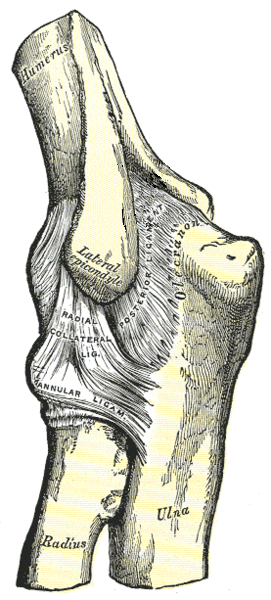Lateral
Epicondylitis
(aka Tennis Elbow)

What is Lateral Epicondylitis?
Lateral Epicondylitis is a condition involving pain in the outer part of the elbow, typically located at the common extensor tendon which originates from the lateral epicondyle.
What are the Symptoms of Lateral Epicondylitis?
Common symptoms include pain in the outer part of the bump of the elbow, which is increased when bending the wrist back (Wrist Extension) and when lifting items or fighting gravity while moving the wrist (e.g. pouring water from a pitcher). Any movement with the palm down i.e. with the hands fully Pronated can also be painful, even when not lifting an item. This pain can then become intense and radiate down the forearm into the back of the hand and into the middle and ring fingers. Typically a sensation of pins and needles or numbness in the elbow are not associated symptoms.
What Causes Lateral Epicondylitis to Develop?
Typically Lateral Epicondylitis develops due to a specific acute injury which results in damage to the common extensor tendon or the extensor carpi radialis brevis. These muscles assist in stabilizing the wrist while performing twisting movements. However it can also arise due to repeated activities leading to "micro-tears" in the tendon as opposed to one specific event, such as exerting Static Grip Force repeatedly while performing tasks like hammering, using hand tools or even mousing on a computer.
What Movements Should be Avoided if you have Lateral Epicondylitis ?
The best course of action is to try to avoid Wrist Extension and Pronation, and any activities which require significant consistent grip (i.e. holding a baseball bat / golf club, rock climbing, lifting objects while the arm is fully extended, pulling out thick file folders from drawers, gripping a conventional mouse, etc.).
Keyboard and mouse use can also trigger discomfort as the actions required to use these devices typically involve repeated pulling of the muscles, which can prevent the inflammation from subsiding and the micro-tears healing.
What Types of Products can be Used to Help Prevent or Reduce the Symptoms and Incidence of Lateral Epicondylitis?
To help prevent Wrist Extension, Articulating Keyboard Arms or Adjustable Height Workstations will ensure the proper height for using keyboards and mice. In addition, consider choosing keyboards with a low, neutral profile (i.e. those where the function row is the same height or lower than the space bar on the keyboard).
To assist in reducing Pronation, consider Orthopedic Mice or Vertical Mice which reduce or eliminate the requirement to pronate while mousing. These mice will position the hand closer to the so-called position of function and reduce the amount of pronation in the hand while mousing. Also consider Adjustable Keyboards to reduce the degree of Pronation required to keyboard.
To reduce repetitive grip activities arising from the Static Grip Force on the mouse, consider alternatives to conventional mice including Touchpads, Trackballs or Central Pointing Devices.
Lifting and repositioning of materials while the arm is extended can be avoided by Writing Surfaces, Document Holders, Book Holders.
